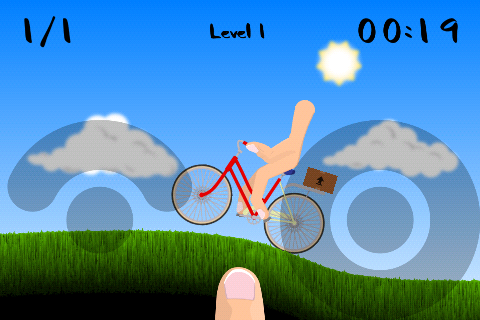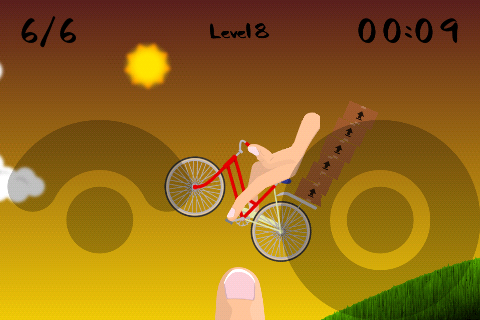Ride your bicycle through the terrains of a grassy hill with some rocks in this 2D physics bicycle side scrolling game.
Free on Google Play!
Fingermail has controls that let you feel like you are actually riding a bicycle... if riding a bicycle was an app. The layout of and style of the controls bring an all new way to play a bicycle game, only possible due to touch screens.
The in-game controls require and allow you to pedal for speed, lean for balance, and brake both front and rear wheels.
Steady driving and control against the forces of physics are required to keep the important packages of highly fragile glass balanced on your bicycle rack to deliver to the other end of the level.
Download for Android from Google Play or from Amazon (Kindle).
If you have the skill; keep all the packages, and then if you have the speed; beat your old time.
- Featuring:
- 20 levels
- Customizable bike colour
- Full bicycle control
- FullHD graphics
Unique game-play could be a thing of every game made for multi-touch-screen devices. Unless the game has been ported from PC, or is designed to be cross-platform, then every touch screen game could and should have unique game-play.
In the past; game-play matched the controller. The keyboard saw MUDs, the gamepad (and the keyboard) saw platformers and scrollers, the mouse saw RPGs and GUI programs, dual analogue sticks (and the keyboard & mouse combined) saw first person shooters, the steering wheel saw racing games, and the joystick saw flight simulation.
Now the multi-touch surface sees the same old game-play of the past. Not even with new experience, again just another mario clone, another racing game, another FPS, or another RPG.
Rather than the game-play being limited by the controller, it is now the controller being limited by the game-play.
Controller Design Examples in Side Scrolling Bike Games
Side-scrolling bike games have been around for decades, probably most originally as shockwave games. These games used the directional arrows on a keyboard with right and left as forward and backward, and up and down as jump and brake.
Later examples (but still quite old) of bike games that came with physics engines are those such as Elasto Mania and clones such as Xmoto. The provided a unique game-play through the way the bike acted in the physics based world, still limited to the computer keyboard Xmoto (for example) switched the arrow keys around, having; up accelerate, down brake, right rotate clockwise and left rotate anticlockwise, in addition to adding space-bar to flip the direction.
Bad Controller Design
Without naming any examples there are so many that could be used that exist on the play store. Side-scrolling motorbike, motorcross, buggy, car, etc games that use two buttons, one in each bottom corner, to represent "Go" on one and "Jump" on the other is not only dull but also quite ugly when cluttered on top of the content.
The Fix? Taking a motorbike game as the example; through some simple changes the interface can become quite interactive.
Instead of a "Go" button; a top down view of a motorbike handle could take its place and dragging down on this can increase acceleration. A simple set of sprites, or a scrolling image, could be used to give the appearance that it is rotating. And on release it would spring back up (similar to that of a motorbike handle).
Instead of a "Jump" button; (and to match the accelerator) some sort of spring icon that can be dragged downwards to represent how much spring the bike will have on release. The further it is dragged down the higher the bike will jump. The spring is dragged down as the bike in the game mimics a downward force being put onto the axles, on release the bike thrusts itself off with as much force applied.
Unique Controller Design
An example of unique and exotic controller design can be experienced in the game "Fingermail".
This game relies on a controller that does not exist and can only exist (at this point in time) through a multi-touch-screen device.
Holding the device with two hands horizontally, the games controls layout is like this in the images below:
The left thumb controlling the font wheel brake and the leaning of the character, and the right thumb controlling the rear wheel brake and the pedalling through an anti-clockwise motion. Coupled with physics the game allows somewhat of a representation of controlling a bicycle, an alternate controller could only be an actual bicycle.
The game-play involves riding steadily enough to reach the end of the level whilst keeping as many boxes on the back bicycle rack as possible. However, even without this added goal, the controls of the bicycle allow for a challenging and an engaging interaction that could provide as much enjoyment through a free-roam type situation.
Peroration
As this focused on side-scrolling driving/racing games a lot is left unexplored in other genres, many containing both good and bad examples of controller design on touch screens. Also, as this focused on only multi-touch-screen design a lot is left unexplored in other functions that come with most touch-screen devices, such as gyroscopes, cameras and microphones, to which there are some unique games which incorporate these.
However, in conclusion, SlideDB sees a lot of mobile and tablet games that have a lot of hard work put into them, bringing engaging game-play whether it's through uniqueness, storyline, or both. But with the platforms available to sell these on being filled with games made by monkey developers who don't even want to try, Indie devs are going to go hungry.
Game Over. GG.




















